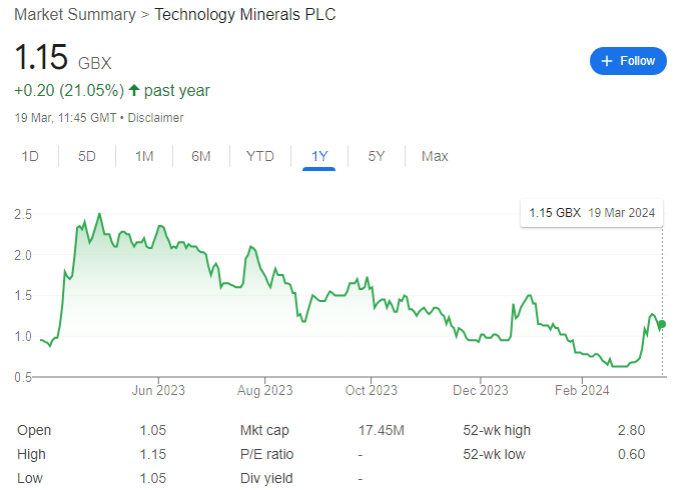The stock tanks and then soars. Shenanigans are afoot. Here’s my quick thoughts on what is really going on.
At some point, I plan to cover TM1 as part of an Edit piece, but for now, I wanted to take 10 minutes and have a look at the share price action in 2024.

First things first: the company needs to drop the Leinster Lithium project in Ireland — or anything non-core. It really does not fit with the corporate narrative anymore. But whatever, that’s a secondary concern.
The real question is this: how did the share price drop to 0.63p in late February 2024, and then rocket to 1.15p today?
Here’s what’s going on.
Bond. Convertible Bond
First, let’s look at the convertible bonds. I said something similar when the bonds announcement was first made in early January, but for brevity:
The company gets access to immediate capital — £5 million — which it needs to ramp up operations until revenue generated is enough to operate profitably. £1 million is specifically for working capital at the Recyclus battery recycling plant — which is good news — while the warrants to CLG arguably align their interests with positive company performance, as the exercise price was at a premium to the then share price.
Of course, CLG can make more money forward selling. Or so they thought.
And negatively, convertible bonds and warrants typically lead to shareholder dilution; increased debt is a risk as you either repay the bonds or convert them to equity. Extending those previous CLNs typically suggests financial problems, as does the offer to current warrant holders to lower their exercise price.
But you have to consider the individual company: the battery recycling plant is operating and revenue generating, so the company argument is that the growth it will see from these combined financial decisions will far outweigh the disadvantages — and it’s at a critical juncture where it needs cash now.
TM1 plans to ramp up to 22,000 tonnes of lithium-ion battery recycling by 2025, and investment Recyclus has been recently named directly by the UK Battery Strategy as the ‘country’s first and only industrial-scale recycling facility.’
This funding buys time to get to profitability, but there was a clear risk of a death spiral if the company missed self-imposed targets. Regardless of any positive and negative views, the reality is that there are limited funding options in the current market — just look at raises at steep discounts everywhere from Avacta, to Baron Oil to ARC Minerals ad infinitum.
The bottom line though for TM1 is that they have to deliver profits on time, because if not the bonds could strangle them. This was clear when the CLN RNS released, and this risk arguably started the share price fall down to the 0.63p level.
But the share price action does not appear to be a natural reaction to the bonds themselves. What has clearly happened is that the death spiral was forward sold by CLG, equivalent to at least £1 million over January, artificially dropping the share price by more than 50%.
Okay, maybe not, but it would make sense.
But with the prospectus now expected within the next couple of weeks, investors have been buying back — and if TM1 can simply get some cash flow announcements RNS’d, you will get an even bigger bounce. But even though the prospectus and rebrand to Recyclus is expected in early April, this should not be enough to send the share price back above 1p. It can’t be just resiliently positive sentiment driving the share price up, leaving CLG short (and caught short) on TM1.
My theory is that TM1 has managed to get the initial £1 million loan repaid from somewhere else, forcing CLG to rebuy shares on the market, and this is creating the short squeeze. Right now, CLG is being forced to buy back millions of shares at a higher price, on the open market — and they have a big problem, because when the prospectus lands, the share price will rise even higher.
Where did this money come from is the question? Management’s spent significant time in Saudi Arabia, and then there’s the Chris Cleverly question to consider. TM1’s recent RNS was comprised of very carefully worded legal language around exclusionary clauses.
He might not be involved in the ‘day-to-day operations’ but what about longer-term strategy?
It might say ‘Mr Cleverly and any of his associated businesses do not hold any shares in either Technology Minerals or Recyclus,’ but he could still hold shares through an intermediary company, at which he is a client, but which he does not own.
Here is what I imagine has happened. TM1 is known to be in a weak financial position. Potential clients want recycling services too cheaply, and TM1 has refused to budge on its pricing, knowing that offering a discount for its services will fast become a slippery slope. The company then runs out of money, and is forced to sign CLNs. It still won’t budge.
Then, realising TM1 is not going to move, clients finally agree to TM1’s pricing model (or they come to a mutually acceptable compromise). Suddenly, revenue is streaming in — and clients perhaps have paid some cash up front. Suddenly the CLNs are not needed anymore….
The bottom line
But the bottom line is that TM1 now has a strong investment case; recent commercial agreements including Servicesure Autocentres, the UK-India tie-up, and the Beryl e-bike contract all point to a company which has secured a future. Then there’s Anwar Sattar to consider — brought on board as Scientific Director in January.
The prospectus for the RTO transaction, whereby TM1 will become Recyclus next month — is being circulated very soon. Revenues are expected to start coming out of lead acid battery plant Tipton any day now — and then there’s the licence application for a TFS licence to export Black Mass, another revenue stream.
All it takes is one plant running at profit; and you also have a new government planning to spend billions on green development in the next Parliament. I suppose Leinster is also a potential profit-maker, but as mentioned above, personally I think it no longer fits the corporate profile.
But the point is that TM1 has an enviable position, with a strong economic moat as the only industrial scale recycling facility in the UK for lithium-ion batteries. And if they have secured finance from elsewhere, investors will soon know.
Interesting times ahead.
This article has been prepared for information purposes only by Charles Archer. It does not constitute advice, and no party accepts any liability for either accuracy or for investing decisions made using the information provided.
Further, it is not intended for distribution to, or use by, any person in any country or jurisdiction where such distribution or use would be contrary to local law or regulation.


Looking forward to an update on this article, as the share price has been in decline ever since. Will it ever recover?